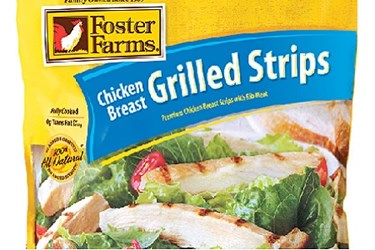Foster Farms Issues Another Recall And How It Could've Been Prevented
By Laurel Maloy, contributing writer, Food Online

A simple mistake at a Louisiana Foster Farms facility is the cause of the latest recall of Foster Farms’ pre-cooked chicken products
The USDA’s Food Safety and Inspection Service (FSIS) announced that a Foster Farms plant in Farmerville, LA is recalling almost 40,000 pounds of frozen, pre-cooked chicken products. The company’s Chicken Breast Grilled Strips, produced on Aug 5, 2014, tested positive for Listeria Monocytogenes. Some of the product was set apart, but a routine in-plant inspection determined that some of the product was “inadvertently shipped.” No reports of illness have been received as a result of this error, but Foster Farms is concerned this product may still be in consumer’s freezers. Shipped to retail warehouse locations in CA, TX, UT, and WA, the 3.25-pound re-sealable, plastic bags will bear the establishment number “P-33901”, in addition to the Best by Date of 08-05-15.
Ensuring Food Safety And Compliance With A Quality Management System
Listeria is particularly dangerous, as it is not susceptible to cold or freezing temperatures. It can be subjugated by cooking, but is also capable of being resuscitated. In ideal conditions, previously heat-injured, and thought to be harmless, Listeria can “rise from the dead.” The most recent large-scale recall, involving almost 93,000 pounds, was attributed to Listeria in pre-cooked chicken topping ready-to-eat salads. Listeria can also live in food-processing facilities for years, re-infecting product, seemingly, at its will. It is commonly found in water, soil, and in healthy animals, and can easily be a source for contamination if not identified and eliminated. Listeria could easily play the part of a prolific, deadly life form in a science fiction thriller. The Centers for Disease Control and Prevention (CDC) identifies Listeriosis, the infection caused by Listeria monocytogenes, as an important public health problem in the U.S.
Researchers are making exceptional strides in Listeria detection. Environmental Listeria (EL) Plates seem to be one of the most-promising, cutting-edge developments. These plates can be utilized on the line to quickly and accurately analyze environmental samples. Detecting both injured and healthy Listeria pathogens on environmental surfaces, the test results are available in a short 27 to 31 hours. However, the best means by which to escape headlines such as this is to prevent pathogenic contamination to begin with. Every facility has the tools at its disposal; simply implement Current Good Manufacturing Practices (CGMP) and Hazard Analysis and Risk-Based Preventive Controls (HARPC).
Case Study: Check out how one company ensured training consistency across all its facilities
In this instance, the segregated area should be identified as a Critical Control Point (CPP) and the means by which to prevent inadvertent shipping identified. The preventive tool may have been as simple as marking each pallet with a big red X or skull and cross-bones. Plants tend to have a high turnover of employees. In many cases, training is on-the-job, and simply omitting one aspect of the training can result in “inadvertent” errors, leading to consumer illness and death.
According to Foster Farms, the product was segregated, but evidently not well enough. The product was most likely held in an isolated area and even marked in some way; however, it was shipped anyway. Several preventative measures could have stopped the product from being shipped; even something as simple as marking contaminated products with a universal symbol for danger may have stopped this recall. However, a hiccup in critical control points has put Foster Farms back into headlines for contaminated poultry products.
